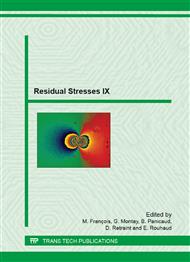p.532
p.538
p.544
p.550
p.556
p.562
p.568
p.574
p.580
Estimation of Cross-Sectional Residual Stress Distributionon Hardened Layer of Carburized Chromium-Molybdenum Steel by Electron Backscattering Diffraction Method
Abstract:
A chromiummolybdenum steel composed of 0.20 mass% carbon was used as a starting material. Three kinds of specimens having different case depths were made by carburizing and quenching. Using the scanning electron microscope, the crystallographic information was measured on the cross-sectional hardened layer by EBSD (electron backscattering diffraction) technique. The KAM (kernel average misorientation, Θ) maps were calculated from the carburized surface to the interior below the case depth of each specimen. The area-average, Θmean, of the KAM map was compared to the case depth and the cross-sectional residual stress distribution measured by x-ray. As a result, the area-average of the hardened layer was larger than that of the interior of specimen after quenching. The estimated depth of the increment in the Θmean was found to accord to the case depth and be proportional to the depth in which large compressive residual stress was distributed on the gradually polished surface. Therefore, both the case depth and eigen strain distribution that induce the compressive residual stress are indirectly estimable by electron backscattering diffraction method.
Info:
Periodical:
Pages:
556-561
Citation:
Online since:
August 2014
Authors:
Permissions:
Share:
Citation:


